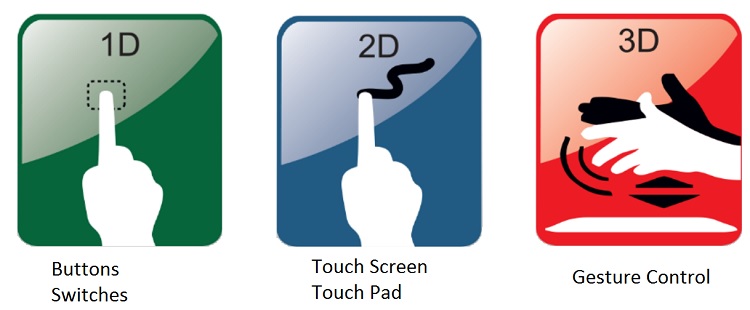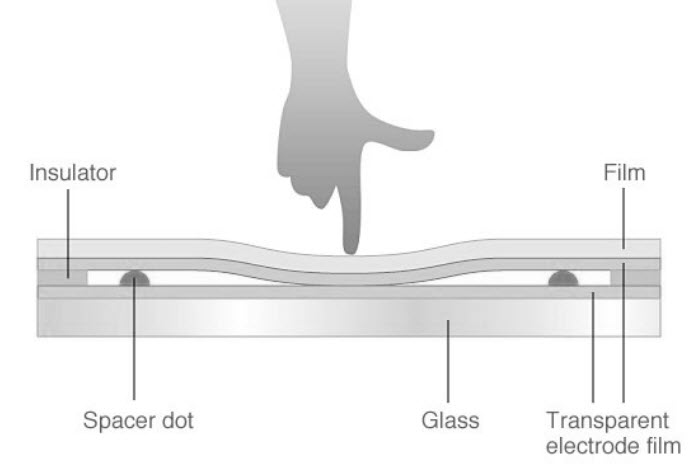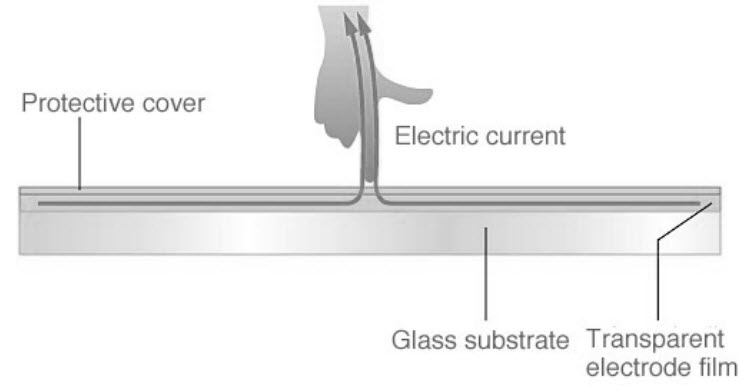With the increase in demand for intuitive and easy GUI (graphical user interface), the development in touch screen technology has also taken an exponential curve. So, we will try to learn a little about touch screen technology, different types of touch screen technologies available, the advantages and disadvantages of each technology etc.
What is a Touch Screen?
Simply speaking, a Touch Screen is an input device in an electronic system. Traditionally, if we take our computers, the input devices include keyboard and mouse. But in a touch screen, you can provide the input to the system, well, by simply touching the screen. A touch screen device may or may not include an electronic display unit but in most cases the touch screen technology is usually fixed on top of a display unit (like in a mobile phone). The way we interact with our electronic devices like TVs and mobiles has been completely changed with the touch screen technology. For example, the interaction with a computer is made very simple as you control the computer directly through its display without the need for other input devices.
2D Human Machine Interface
Touch screens is a type of User Interface, which allows touch based human machine interface. It is considered to be a two-dimensional sensing device. If you take buttons into account (touch or tactile), they provide a single point of contact. Hence, they are one-dimensional input devices.
Coming to touch screens (or touch pads), you can touch, drag, write swipe, pinch etc. in the x-y plane. Hence, they are two-dimensional input devices. There is a three-dimensional user interface known as Gesture Control, where hand gestures in free space act as input.
Components of a Touch Screen
Any touch screen device, whether a mobile phone or a tablet computer, usually consists of three important components. They are:
Touch Sensor Controller Software
The Touch Sensor is the device which measures the parameters of contact between the device and the device and an object. It measures the contact force at any point. Controller is responsible for capturing the “touch” information from the touch sensor and provide it to a main controlling device like a microcontroller or a processor. Finally, the software is responsible for the main microcontroller or processor to work in harmony with the touch sensor and its controller.
Touch Screen Technology Types
Based on the types of Touch Sensor used in the development of a touch screen, there are 5 types of touch screen technologies. They are:
Resistive Touch Screen Technology Capacitive Touch Screen Technology Infrared Touch Screen Technology Acoustic Wave Touch Screen Technology Near Field Imaging Touch Screen Technology
Let us briefly understand about each of these technologies. But before going into the details, one point you should remember is that almost all touch screen devices are usually part of a display unit like an LCD, TFT, LED, CRT etc.
Resistive Touch Screen Technology
It is one of the most commonly used touch screen technologies. It consists of a glass panel that is coated with two electrically conductive thin metallic layers which are separated by a narrow gap consisting of separator dots.
When a user touches a point on the outer surface of the panel, the two metallic conductive layers come into contact. With the voltage passing through the panel, the metal contacts act as a voltage divider and the change in voltage can be used to determine the point of contact. Advantages
Resistive Touch Screens are extremely durable and can be used in tough and harsh environments. These are generally lower in cost when compared to other technologies. The surface is resistant to liquids like oil, grease etc. and other contaminants like dust and moisture. Power consumption is also less.
Disadvantages
One of the main disadvantages of resistive touch screens is their low clarity. The outer film is susceptible to scratching or being damaged by sharp objects.
Capacitive Touch Screen Technology
The capacitive based touch screen technology is the most popular technology now-a-days. In a capacitive touch screen, the glass panel is coated with a thin, transparent, charge storing electrode layer. The electrical conductivity of the human body plays an important role in capacitive touch screens. When a human finger touches the screen, the electrode layer reacts to the static electricity of the human body. Sensors located at the four corners of the screen measure the changes in capacitance.
As the human touches the screen with their finger, the sensors measure the difference in capacitance and flow of current, which is directly proportional to the distance of the point of contact from the corner. Capacitive touch screens are again divided into two types. They are:
Surface Capacitive Touch Screen Technology Projected Capacitive Touch Screen Technology
In surface capacitive technology, one side of the glass panel is coated with conductive layer while the other layer is left uncoated and is expose for human touch. When the human touches the screen, a dynamic capacitor is formed due to the static charge of the human. The point of contact is measured by measuring the capacitance from four corners. In projected capacitive technology, there is a glass panel with coating of electrode films and an IC to create a 3D electrostatic field. The IC determines the point of contact by measuring the ratio of electrical current. Advantages
Capacitive Touch Screen Technology provide better clarity than Resistive technology. Due to lack of moving parts, this is more durable. The screen is resistant to dust, oil, water etc. High resistance to scratches. Provided multi-touch inputs.
Disadvantages
Since capacitance is key in its functioning, it is sensitive to EMI and RFI. It is prone to parasitic capacitance and requires calibration.
Infrared Touch Screen Technology
A Scanning Infrared Touchscreen Technology is based on the interruption of infrared light on the screen. The panel consists of an array of infrared LEDs and photo transistors that are positioned on the opposite sides. This setup creates an invisible grid of infrared light beams on the front of the screen. When a finger is placed on the screen, the sensors can determine the point of contact as the point of interruption of the light. Advantages
Virtually any object can be used for touch input, whether it may be a finger or a stylus. Infrared Touch Screen technology has the highest clarity among all the touchscreen technologies. It is unaffected by surface scratches.
Disadvantages
There is a chance that screen reacts even before the finger (or stylus) touches the screen. Dust, oil etc. can prevent the light beam from passing and causes a malfunction. Costlier than other technologies. Ambient light may have an effect on its operation.
Acoustic Wave Touch Screen Technology
The acoustic wave touchscreen technology is one of the most advanced touch screen designs. This technology is based on sending acoustic or sound waves through the glass panel. In this technology, the panel consists of a series of piezoelectric transducers and receivers laid along its sides. When a human finger touches the screen, that portion of the sound wave is absorbed allowing the transducer identify the point of contact. There are two types of Acoustic wave technologies. They are:
Surface Acoustic Wave Touch Screen Technology Guided Acoustic Wave Touch Screen Technology
Advantages
Like Infrared Technology, acoustic wave technology is very durable as it contains only the glass panel without any layers or coatings. Fingers, stylus, gloved hands all can be used with acoustic wave screens. Scratch resistant.
Disadvantages
Water may be a problem and might cause false triggering. Contaminants like dust and moisture can create unidentified zones on the screen.
Near Field Imaging Touch Screen Technology
The Near Field Imaging or NFI Touchscreen is a proprietary technology which uses a patterned coating of conductive film on the glass panel on one side and complete coating on the other. An excitation signal is supplied to the panel to generate an electrostatic field. When a finger comes into contact, the electrostatic field changes and this is used determine the point of contact. Comment * Name * Email * Website
Δ








![]()